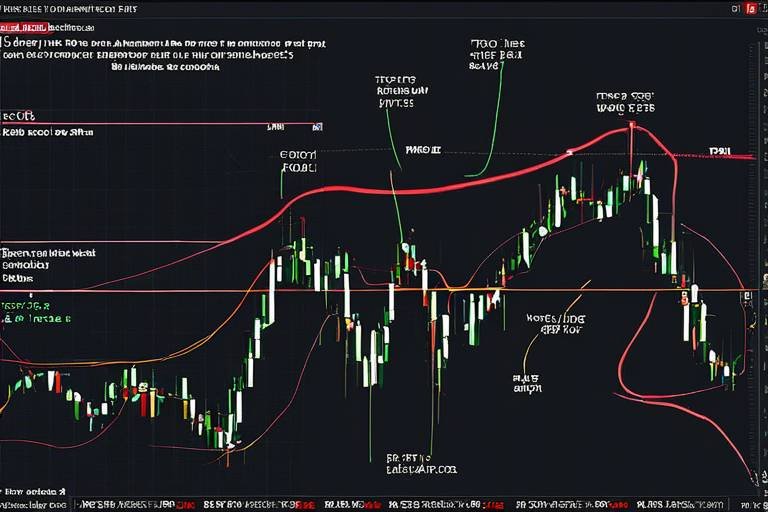Creating a Trade Plan for Initial Coin Offerings (ICOs)
In the rapidly evolving world of cryptocurrency, Initial Coin Offerings (ICOs) have emerged as a popular method for startups to raise funds. However, diving into ICO investments without a solid trade plan can feel like jumping into the deep end without knowing how to swim. A well-structured trade plan is essential to navigate this turbulent waters, ensuring that you make informed decisions while maximizing your investment potential.
The first step in crafting your trade plan is to understand the landscape of ICOs. These fundraising mechanisms allow companies to issue their own tokens in exchange for established cryptocurrencies, like Bitcoin or Ethereum. This unique structure not only provides startups with the capital they need to launch their projects but also offers investors a chance to get in on the ground floor of potentially revolutionary technologies. However, with great opportunity comes great risk, and that’s where your trade plan comes into play.
Next, you'll want to set clear investment goals. What are you hoping to achieve with your ICO investments? Are you looking for short-term gains, or are you in it for the long haul? Defining your objectives based on your risk tolerance and expected returns is crucial. For instance, if you're comfortable with high-risk investments, you might aim for projects that have the potential for explosive growth but also carry a higher chance of failure. On the other hand, if you prefer a more conservative approach, you might focus on established projects with proven track records.
ICOs serve a dual purpose: they provide startups with the necessary funds to develop their projects and give investors early access to new tokens. This innovative fundraising method has transformed the way businesses operate, allowing them to bypass traditional venture capital routes. However, understanding the intricacies of ICOs is vital. Investors must be aware of the benefits and challenges associated with these investments. For example, while ICOs can yield substantial returns, they are also susceptible to fraud and market manipulation.
Once you have a grasp of what ICOs are, it’s time to set your investment goals. Think of this step as plotting your course on a map before embarking on a journey. Are you aiming for a steady income from your investments, or are you chasing after that life-changing jackpot? By defining your goals, you can tailor your trade plan to align with your personal financial aspirations.
Risk assessment is a critical component of your trade plan. The world of ICOs is fraught with uncertainties, and understanding these risks can help you navigate them more effectively. Common risks include market volatility, regulatory changes, and the potential for project failure. By identifying these risks, you can develop strategies to mitigate them, such as diversifying your portfolio or setting stop-loss orders to protect your investments.
Market volatility can be likened to a roller coaster ride—thrilling but unpredictable. The prices of ICO tokens can fluctuate wildly based on market sentiment, news events, and investor behavior. By keeping an eye on market trends and employing technical analysis, you can better anticipate these price movements and make informed decisions about when to buy or sell.
Regulatory risks are another critical factor to consider. The legal landscape surrounding ICOs is constantly evolving, with governments around the world implementing new regulations. Staying informed about these changes can help you adapt your investment strategy accordingly. For instance, if a country imposes strict regulations on ICOs, it could impact the viability of projects in that region.
Conducting thorough research on ICO projects is essential for making informed investment choices. Look for key factors such as the project's whitepaper, the team behind it, and its roadmap. A well-documented whitepaper should clearly outline the project's objectives, technology, and potential market impact. Additionally, a strong team with relevant experience can significantly enhance a project's credibility. Don't forget to check community sentiment on platforms like Reddit or Telegram, as these can provide valuable insights into the project's reputation.
With your research complete, it’s time to develop a trading strategy. Think of this as your game plan—how will you approach the market? There are various strategies you can adopt, depending on your investment goals and risk tolerance. For instance, some investors prefer a buy-and-hold strategy, while others may opt for day trading to capitalize on short-term price movements.
Identifying optimal entry and exit points is fundamental for maximizing profits. Consider using technical indicators like moving averages or the Relative Strength Index (RSI) to help determine when to enter or exit a trade. By setting clear criteria for these points, you can take the emotion out of trading and make more rational decisions.
Technical analysis can be a powerful tool in your trading arsenal. By analyzing historical price movements, you can identify patterns and trends that may indicate future performance. Familiarize yourself with essential tools such as candlestick charts, volume indicators, and trend lines to enhance your trading skills.
- What is an ICO? An Initial Coin Offering (ICO) is a fundraising mechanism where new projects sell their underlying crypto tokens in exchange for established cryptocurrencies.
- How do I choose a good ICO to invest in? Look for a well-documented whitepaper, experienced team members, and positive community feedback.
- What are the risks associated with ICOs? Risks include market volatility, regulatory changes, and the potential for project failure.
- How can I mitigate risks in ICO investments? Diversify your portfolio, set stop-loss orders, and stay informed about market trends and regulations.

Understanding ICOs
Initial Coin Offerings, or ICOs, have emerged as a revolutionary fundraising mechanism in the world of cryptocurrency. They serve as a bridge between startups looking for capital and investors seeking new opportunities. At their core, ICOs allow companies to raise funds by issuing digital tokens in exchange for established cryptocurrencies like Bitcoin or Ethereum. This innovative approach not only democratizes investment but also opens the door to a plethora of possibilities for both startups and investors alike.
So, why should you care about ICOs? For startups, they represent a chance to bypass traditional funding routes, such as venture capital or bank loans. This is particularly appealing in a landscape where securing funding can be a daunting task. By launching an ICO, companies can reach a global audience, allowing them to gather the necessary capital to bring their innovative ideas to life. On the flip side, investors have the opportunity to get in on the ground floor of potentially groundbreaking projects. However, it's crucial to understand that with great opportunity comes great responsibility.
To truly grasp the essence of ICOs, let's break down their structure and benefits:
- Token Creation: Startups create a unique token that often serves a specific purpose within their platform or ecosystem.
- Investment Opportunity: Investors can purchase these tokens, often at a lower price before they hit the market.
- Community Building: ICOs foster a sense of community as early backers often become advocates for the project.
- Decentralization: Unlike traditional fundraising, ICOs operate on a decentralized model, which can lead to greater transparency.
However, it's essential to approach ICOs with caution. The rapid growth of this fundraising model has also attracted its fair share of scams and fraudulent projects. As an investor, conducting thorough due diligence is non-negotiable. Look for projects with a solid whitepaper, a clear business model, and a transparent team behind them. In fact, many successful ICOs provide detailed documentation outlining their vision, technology, and roadmap, which can be invaluable in assessing their credibility.
In summary, understanding ICOs involves recognizing their dual role as both a funding mechanism for startups and an investment opportunity for individuals. While the potential for high returns exists, so do the risks. By educating yourself on the structure, benefits, and potential pitfalls of ICOs, you can navigate this exciting yet volatile landscape with greater confidence.

Setting Investment Goals
When it comes to investing in Initial Coin Offerings (ICOs), setting clear and achievable investment goals is not just a good practice—it's essential. Think of your investment goals as a roadmap; without it, you might find yourself wandering aimlessly in the vast, unpredictable landscape of cryptocurrency. So, how do you establish these goals? It starts with understanding your own financial situation and what you hope to achieve.
First and foremost, consider your risk tolerance. Are you someone who can sleep at night knowing your investments could fluctuate wildly, or do you prefer a more stable approach? Knowing where you stand on the risk spectrum can help you tailor your investment goals accordingly. For example, if you have a low risk tolerance, you might aim for modest returns with safer, more established projects, while a high-risk taker might set their sights on high-reward ICOs that come with greater uncertainty.
Next, think about your time horizon. Are you looking for short-term gains, or are you in it for the long haul? If you're planning to hold your investments for several years, you might set different goals compared to someone looking to cash out within a few months. This consideration can significantly influence the types of ICOs you choose to invest in.
Once you've assessed your risk tolerance and time horizon, it’s time to set specific, measurable, achievable, relevant, and time-bound (SMART) goals. This framework can help clarify your objectives and keep you focused. For instance, instead of saying, "I want to make money from ICOs," you could say, "I aim to invest $1,000 in three promising ICOs over the next six months and achieve a 20% return by the end of the year." This kind of specificity not only keeps you accountable but also helps you evaluate your success later.
To further enhance your goal-setting process, consider creating a table that outlines your investment objectives, the associated risks, and your expected returns. Here’s a simple example:
| Investment Goal | Risk Level | Expected Return | Time Frame |
|---|---|---|---|
| Invest in established ICOs | Low | 10% | 1 year |
| Invest in high-potential startups | High | 50% | 6 months |
| Diversify across multiple ICOs | Medium | 30% | 1 year |
Lastly, don’t forget to periodically review and adjust your goals as needed. The cryptocurrency market is notorious for its volatility, and what seemed like a solid goal a few months ago might not hold up today. Regularly reassessing your investment objectives ensures that you remain aligned with your financial aspirations and market conditions.
In summary, setting investment goals is a crucial step in developing a robust trade plan for ICOs. By understanding your risk tolerance, defining your time horizon, utilizing the SMART framework, and regularly reviewing your goals, you can navigate the exciting yet unpredictable world of ICO investments with confidence.
- What is a reasonable return on investment for ICOs? A reasonable return can vary widely, but many investors aim for at least 20% annually, depending on their risk tolerance.
- How do I know if an ICO is worth investing in? Conduct thorough research, evaluate the team behind the project, and analyze market trends.
- Is it safe to invest in ICOs? Like all investments, ICOs come with risks. It's crucial to assess your risk tolerance and diversify your investments.

Risk Assessment
When diving into the world of Initial Coin Offerings (ICOs), it's essential to conduct a thorough . Just like a sailor wouldn't set sail without checking the weather, you shouldn't invest without understanding the potential pitfalls. ICOs can be a wild ride, and recognizing the risks involved can help you navigate through the choppy waters of cryptocurrency investment.
First and foremost, one of the most significant risks is the market volatility. The cryptocurrency market is notorious for its price swings. One day you might see a coin skyrocket in value, and the next, it could plummet. This volatility can be thrilling but also dangerous. To mitigate this risk, consider employing strategies like dollar-cost averaging, which involves investing a fixed amount regularly, regardless of the coin's price. This approach can help cushion the impact of sudden price changes.
Another critical aspect of risk assessment is understanding regulatory risks. The legal landscape surrounding ICOs is constantly evolving. Governments around the world are still figuring out how to regulate cryptocurrencies, which means that changes in regulations can have immediate effects on your investments. For instance, if a country suddenly bans ICOs, the value of your investment could drop dramatically. Staying informed about regulatory news and developments is crucial to anticipating potential impacts on your investments.
Additionally, it's vital to be aware of project-specific risks. Not all ICOs are created equal, and the success of a project can hinge on various factors, including the team behind it, the technology they are developing, and their business model. Conducting due diligence is essential. Investigate the team’s background, their previous successes or failures, and the project's roadmap. A solid project with a transparent team is less likely to encounter significant risks compared to one shrouded in mystery.
To summarize, a comprehensive risk assessment involves evaluating:
- Market Volatility: Price swings can lead to significant gains or losses.
- Regulatory Risks: Changes in laws can impact the viability of ICOs.
- Project-Specific Risks: The quality and transparency of the project team and their objectives.
By keeping these risks in mind and developing strategies to manage them, you can enhance your investment success in the ICO landscape. Remember, the goal is not to eliminate all risks but to understand and manage them effectively so that you can make informed decisions that align with your financial objectives.
Q1: What is the biggest risk associated with ICOs?
A1: The biggest risk is often market volatility, as prices can fluctuate wildly in a short period. Regulatory risks and project-specific risks also play significant roles.
Q2: How can I protect my investment in an ICO?
A2: Conduct thorough research on the project, understand the team behind it, and stay updated on regulatory changes. Consider diversifying your investments to spread risk.
Q3: Is it possible to recover from a loss in an ICO investment?
A3: Yes, while losses can be significant, the cryptocurrency market is known for its potential for recovery. However, it's essential to have a solid strategy and not invest more than you can afford to lose.

Market Volatility
Market volatility is a term that gets tossed around a lot in the world of investing, especially when it comes to Initial Coin Offerings (ICOs). But what does it really mean? In simple terms, refers to the degree of variation in trading prices over time. Think of it as the wild rollercoaster ride of the cryptocurrency market. One moment, prices are soaring high, and the next, they can plummet dramatically. This unpredictability can be both thrilling and terrifying for investors.
For those looking to invest in ICOs, understanding market volatility is crucial. It can significantly impact not only the value of your investment but also your overall strategy. Imagine you’re at a carnival, trying to decide whether to go on the Ferris wheel or the spinning teacups. If you know the Ferris wheel is a gentle ride (low volatility) and the teacups are a dizzying whirlwind (high volatility), you can make a more informed choice based on your tolerance for risk.
Here are a few key aspects to consider regarding market volatility in the context of ICOs:
- Price Fluctuations: ICO prices can swing wildly based on market sentiment, news, and even social media buzz. An announcement about a partnership can send prices skyrocketing, while a regulatory warning can have the opposite effect.
- Trading Volume: High trading volumes can lead to increased volatility. When many investors buy or sell at once, prices can shift dramatically, making it essential to keep an eye on market activity.
- Market Sentiment: The mood of the market can change in an instant. Positive news can create a buying frenzy, while negative news can trigger panic selling. Understanding these emotional triggers can help you navigate the chaos.
To help visualize the impact of market volatility, consider the following table that outlines how different factors can influence ICO prices:
| Factor | Impact on ICO Prices |
|---|---|
| Positive News (e.g., partnerships) | Price Surge |
| Negative News (e.g., regulatory issues) | Price Drop |
| High Trading Volume | Increased Volatility |
| Market Sentiment Shifts | Rapid Price Changes |
As you can see, market volatility is a double-edged sword. While it can create opportunities for significant gains, it also poses risks that can lead to substantial losses. Therefore, it's essential to develop strategies that account for this volatility. For instance, setting stop-loss orders can help protect your investment during sudden downturns. Additionally, diversifying your portfolio can mitigate risks associated with any single ICO.
Ultimately, embracing market volatility means staying informed and being prepared for the unexpected. By understanding the factors that contribute to price fluctuations, you can make more strategic decisions and enhance your chances of success in the ICO landscape.
Q: What is market volatility?
A: Market volatility refers to the degree of variation in trading prices over time, indicating how much prices fluctuate.
Q: How does volatility affect ICO investments?
A: Volatility can lead to significant price changes, which can result in both gains and losses. Understanding it helps investors make informed decisions.
Q: What strategies can I use to manage volatility?
A: Strategies include setting stop-loss orders, diversifying your portfolio, and staying informed about market trends and news.
Q: Can market sentiment influence ICO prices?
A: Yes, market sentiment can greatly affect prices. Positive news can lead to buying frenzies, while negative news can result in panic selling.

Regulatory Risks
When diving into the world of Initial Coin Offerings (ICOs), one cannot overlook the looming shadow of . These risks can significantly impact the success and viability of an ICO, making it crucial for investors to stay informed. Regulatory frameworks surrounding cryptocurrencies and ICOs are still evolving, and different countries have adopted varying stances. This inconsistency can lead to sudden changes that may affect the legality and operational capacity of a project.
Imagine investing in a promising ICO only to find out that the regulatory body in your country has decided to ban or heavily restrict such offerings. This kind of abrupt change can cause a plummet in token value and leave investors scrambling for answers. Therefore, understanding the regulatory landscape is essential for anyone looking to invest in ICOs.
One of the primary concerns is the classification of tokens. Are they securities, utility tokens, or something else? The definition can vary by jurisdiction, and misclassification can lead to legal troubles for both the project and its investors. For instance, if a token is deemed a security, it must comply with more stringent regulations, which can complicate its launch and trading.
Moreover, the regulatory environment is not static. It can change based on political climates, public sentiment, and even technological advancements. For example, a country that previously welcomed ICOs might suddenly impose strict regulations following a major fraud case. This unpredictability adds an extra layer of complexity for investors.
To navigate these regulatory waters, it's wise to:
- Stay updated on news related to cryptocurrency regulations in your country.
- Consult legal experts or resources that specialize in cryptocurrency law.
- Engage with community forums to gather insights and share experiences with other investors.
In summary, while ICOs present exciting investment opportunities, the involved cannot be ignored. By conducting thorough research and staying proactive about regulatory changes, investors can better protect their investments and make informed decisions.
Q: What are the main regulatory bodies overseeing ICOs?
A: Regulatory bodies vary by country. For example, in the United States, the Securities and Exchange Commission (SEC) plays a significant role, while in the European Union, it can vary by member state.
Q: How can I determine if an ICO is compliant with regulations?
A: Review the project's whitepaper and any legal disclaimers provided. Additionally, check if the ICO has undergone legal scrutiny or has received endorsements from recognized regulatory bodies.
Q: What should I do if the regulations change after I invest?
A: Stay informed about the changes and consult with financial or legal advisors to understand the implications for your investment. Being proactive can help mitigate potential losses.

Researching ICO Projects
When it comes to investing in Initial Coin Offerings (ICOs), conducting thorough research is not just a good practice; it's an absolute necessity. The cryptocurrency landscape is riddled with opportunities, but it’s also fraught with pitfalls. Imagine walking into a candy store where everything looks delicious, but you know that some candies are laced with poison. Similarly, while many ICOs promise significant returns, some may turn out to be scams or poorly structured projects. So, how do you navigate this candy store of ICOs without getting burned?
First and foremost, you need to dive deep into the project's whitepaper. This document is the backbone of any ICO, outlining the project's vision, technology, and roadmap. A well-crafted whitepaper should be clear, comprehensive, and devoid of jargon that can confuse potential investors. Look for key elements such as:
- Problem Statement: What issue is the project aiming to solve?
- Technology: What technology underpins the project, and is it innovative?
- Tokenomics: How is the token structured? What are its use cases?
- Roadmap: What are the milestones, and are they realistic?
Next, you should investigate the team behind the ICO. A project is only as good as the people driving it. Look for team members with proven track records in their respective fields. Do they have experience in blockchain technology? Have they successfully launched projects before? You might want to check their LinkedIn profiles or other social media platforms to gauge their credibility and expertise. Remember, a strong team can be a significant indicator of a project's potential success.
Don’t overlook the importance of community engagement. A vibrant community can be a strong indicator of an ICO's potential. Check out forums, social media channels, and platforms like Telegram or Discord to see how the community interacts. Are they passionate and engaged, or is the conversation sparse and uninspired? A supportive community often means that the project is on the right track.
Additionally, consider the market demand for the project’s solution. Is there a real need for what the ICO is offering? Look for similar projects in the market and analyze their performance. Are they thriving, or are they struggling? This analysis can provide insights into the potential success of the ICO you are researching.
Finally, pay attention to the regulatory environment. The cryptocurrency market is constantly evolving, and regulations can significantly impact the viability of an ICO. Make sure to stay informed about the legal landscape in your jurisdiction and how it may affect your investment. It’s advisable to consult legal experts if you’re unsure about the implications of investing in a specific ICO.
In summary, researching ICO projects requires a multi-faceted approach. By focusing on the whitepaper, the team, community engagement, market demand, and regulatory considerations, you can arm yourself with the knowledge needed to make informed investment decisions. Remember, in the world of ICOs, knowledge is not just power; it's your best defense against potential losses.

Developing a Trading Strategy
Crafting a solid trading strategy is like building a sturdy house; without a strong foundation, everything else can come crumbling down. When it comes to investing in Initial Coin Offerings (ICOs), having a well-defined strategy tailored to your individual goals and the ever-evolving market conditions is crucial for long-term success. But how do you go about developing such a strategy? It’s simpler than you might think! Let’s break it down step by step.
First and foremost, it’s essential to understand the importance of setting clear objectives. What do you want to achieve with your investments? Are you aiming for short-term gains, or are you in it for the long haul? By identifying your goals, you can create a roadmap that guides your trading decisions. For instance, if you’re looking for quick profits, you might focus on more volatile ICOs, while long-term investors may prefer projects with solid fundamentals and a promising roadmap.
Next, you need to consider your risk tolerance. This aspect is crucial because every investor has a different threshold for risk. Some might be comfortable with high-risk, high-reward scenarios, while others prefer a more conservative approach. A good way to assess your risk tolerance is by asking yourself a few questions:
- How much capital can I afford to lose?
- Am I prepared for the emotional rollercoaster that comes with market fluctuations?
- What is my investment horizon?
Once you have a clear understanding of your goals and risk tolerance, the next step is to develop your trading strategy. This involves selecting the right ICOs to invest in based on thorough research and market analysis. Remember, not all ICOs are created equal! You’ll want to evaluate factors such as the project's team, technology, market demand, and community support. A well-researched investment can significantly increase your chances of success.
Another critical component of your trading strategy is determining your entry and exit points. This is where the magic happens! Identifying when to buy and sell can make or break your investment. You can use various technical analysis tools to help pinpoint these moments, such as moving averages, support and resistance levels, and volume indicators. For instance, if you notice a particular ICO is consistently bouncing off a support level, it might be a good entry point for you.
Moreover, it’s essential to stay updated with market trends and news. The cryptocurrency landscape is incredibly dynamic, and a single piece of news can cause significant price movements. By staying informed, you can make timely decisions that align with your trading strategy. Consider setting up alerts for relevant news or joining communities where you can exchange insights with fellow investors.
Finally, remember that no strategy is foolproof. It’s essential to remain flexible and adjust your approach as market conditions change. This adaptability can be the difference between a successful investor and one who gets left behind. Keep track of your trades and analyze what works and what doesn’t. This ongoing evaluation will help you refine your strategy over time, making you a more effective trader.
In conclusion, developing a trading strategy for ICOs is a multifaceted process that requires careful planning, research, and flexibility. By setting clear goals, assessing your risk tolerance, and staying informed, you can create a strategy that not only enhances your chances of success but also aligns with your personal investment style. Now, let’s dive into some frequently asked questions to further clarify your understanding.
1. What is the best way to research an ICO?
Researching an ICO involves analyzing the project’s whitepaper, understanding the team behind it, and assessing market demand. Look for community feedback and expert opinions to gauge the project’s viability.
2. How much should I invest in an ICO?
The amount you invest should align with your overall financial strategy and risk tolerance. A common rule is to only invest what you can afford to lose.
3. How do I know when to sell my ICO investment?
Selling should be based on your predetermined exit strategy, which may include hitting a specific profit target or reacting to market conditions. Regularly review your investment to decide if it’s time to exit.

Entry and Exit Points
Identifying optimal entry and exit points is fundamental for maximizing profits in the volatile world of Initial Coin Offerings (ICOs). Think of it like fishing; you wouldn’t just cast your line anywhere and hope for the best, right? You need to know when to drop your bait and when to reel in your catch. The same principle applies to trading ICOs. Timing can make all the difference between a lucrative investment and a regrettable loss.
When considering entry points, it’s essential to analyze the market trends and the specific ICO you’re interested in. Look for indicators that suggest a favorable moment to invest. For instance, if a project has just completed its pre-sale and is about to launch its main sale, it could be an ideal time to buy in, especially if the project has garnered positive attention. However, be wary of hype; just because everyone is excited doesn’t mean it’s the right time for you to jump in.
On the flip side, knowing when to exit is equally crucial. The market can shift rapidly, and what seems like a golden opportunity can quickly turn sour. Setting exit points involves determining your profit targets and stop-loss levels beforehand. This means you should have a clear strategy in place. For example, you might decide to sell a portion of your holdings once they appreciate by a certain percentage, or you may choose to cut your losses if the price drops below a specific threshold. Establishing these parameters helps to take the emotion out of trading, allowing you to make decisions based on logic rather than panic.
To further illustrate the importance of entry and exit points, consider the following table that outlines a simple strategy:
| Strategy | Entry Point Criteria | Exit Point Criteria |
|---|---|---|
| Buy and Hold | Invest during the ICO phase or at a low price post-launch. | Sell when the project achieves certain milestones or price targets. |
| Scalping | Enter during price dips or after significant news. | Exit quickly for small profits after short-term price increases. |
| Trend Following | Buy when the price breaks above a defined resistance level. | Sell when the price falls below a defined support level. |
Remember, the key to successful trading is not just knowing when to buy or sell, but also being disciplined in your approach. It’s easy to get caught up in the excitement of a rising market or the panic of a falling one. By sticking to your pre-defined entry and exit points, you can navigate the turbulent waters of ICO investments with greater confidence.
- What is an entry point in ICO trading? An entry point is the moment when an investor decides to buy into an ICO, ideally when the price is low or favorable.
- How do I determine my exit point? Your exit point is determined by your profit targets or loss thresholds, which you should establish before making a trade.
- Can market news affect my entry and exit points? Absolutely! Market news can significantly influence price movements, so staying updated is crucial.
- Is it advisable to adjust my entry and exit points? Yes, being flexible and adjusting your strategy based on market conditions can be beneficial.

Using Technical Analysis
This article explores the essential components of developing a robust trade plan for ICOs, focusing on strategies, risk management, and market analysis to enhance investment success.
A comprehensive overview of Initial Coin Offerings, including their purpose, structure, and the benefits they offer to both startups and investors in the cryptocurrency landscape.
Defining clear investment objectives is crucial for any trade plan. This section discusses how to set realistic goals based on risk tolerance and expected returns.
Evaluating the potential risks associated with ICO investments is vital. This subsection outlines common risks and how to mitigate them effectively.
Understanding the impact of market volatility on ICOs helps investors prepare for price fluctuations and make informed decisions.
This segment examines the regulatory landscape surrounding ICOs and how changes can affect investment strategies.
Conducting thorough research on ICO projects is essential for making informed investment choices. This section highlights key factors to consider during research.
Crafting a solid trading strategy tailored to individual goals and market conditions is crucial. This section discusses various strategies investors can adopt.
Identifying optimal entry and exit points is fundamental for maximizing profits. This subsection provides insights on how to determine these critical moments.
When it comes to investing in Initial Coin Offerings (ICOs), technical analysis can be your best friend. Think of it as a map guiding you through a dense forest of price charts and market trends. By using historical price data and trading volume, you can spot patterns that may indicate future price movements. This is particularly important in the volatile world of cryptocurrencies, where prices can swing dramatically in a matter of hours.
One key aspect of technical analysis is the use of charts. These visual representations of price movements over time allow you to identify trends. For example, a bullish trend indicates that prices are generally rising, while a bearish trend shows a downward movement. By analyzing these trends, you can make more informed decisions about when to buy or sell your ICO tokens.
Additionally, you might want to familiarize yourself with various technical indicators. Here are a few of the most popular ones:
- Moving Averages: These help smooth out price data to identify trends over a specific period.
- Relative Strength Index (RSI): This measures the speed and change of price movements, indicating overbought or oversold conditions.
- MACD (Moving Average Convergence Divergence): This shows the relationship between two moving averages, helping to identify potential buy/sell signals.
It's essential to remember that no indicator is foolproof. Just like a weather forecast, technical analysis can provide insights but cannot predict the future with absolute certainty. Thus, combining these tools with a solid understanding of market sentiment and news can significantly enhance your trading strategy.
Moreover, consider creating a trading journal where you document your trades, the indicators you used, and the outcomes. This practice not only helps in refining your strategies but also allows you to learn from both successes and mistakes over time.
As you delve deeper into technical analysis, you'll find that it’s not just about crunching numbers; it’s about developing a feel for the market. Think of it as learning to dance—at first, it might feel awkward and confusing, but with practice, you’ll find your rhythm and be able to move with confidence.
What is technical analysis?
Technical analysis is a method used to evaluate and predict the future price movements of assets, including cryptocurrencies, by analyzing historical price data and trading volumes.
How can I start using technical analysis for ICOs?
Begin by familiarizing yourself with various chart types and technical indicators. Practice analyzing historical data to identify trends and patterns that can inform your trading decisions.
Is technical analysis foolproof?
No, technical analysis is not foolproof. It provides insights based on historical data, but market conditions can change rapidly, and unexpected events can influence prices.
Should I use technical analysis alone?
It's advisable to combine technical analysis with fundamental analysis and market sentiment for a more comprehensive trading strategy.
Frequently Asked Questions
- What is an Initial Coin Offering (ICO)?
An Initial Coin Offering (ICO) is a fundraising mechanism in which new cryptocurrency projects sell their underlying tokens in exchange for established cryptocurrencies like Bitcoin or Ethereum. ICOs are often used by startups to raise capital for their projects, and they provide investors with early access to new tokens that may appreciate in value.
- How do I set realistic investment goals for ICOs?
Setting realistic investment goals involves assessing your risk tolerance, understanding the market dynamics, and determining the returns you expect from your investments. Consider factors like your financial situation, investment timeline, and how much you’re willing to lose. It's like planning a road trip; you need to know your destination and how much fuel (or money) you have to get there!
- What are the common risks associated with ICO investments?
Common risks include market volatility, regulatory changes, and project failure. Market volatility can lead to sudden price drops, while regulatory risks arise from changing laws that may impact the legality of the ICO. Additionally, not all projects succeed, and it’s essential to conduct thorough research before investing.
- How can I effectively research ICO projects?
To research ICO projects effectively, look into the team behind the project, their whitepaper, and the problem the project aims to solve. Check community feedback, social media presence, and any partnerships or collaborations. Think of it like dating; you want to know the person well before committing!
- What strategies can I use to develop a trading plan for ICOs?
Developing a trading plan involves defining entry and exit points, using technical analysis, and setting stop-loss orders. It’s crucial to adapt your strategy based on market conditions and your investment goals. Just like a chess game, having a strategy can help you anticipate moves and protect your assets!
- How do I identify optimal entry and exit points?
Identifying entry and exit points can be done through technical analysis, which involves studying price charts and indicators. Look for patterns, support and resistance levels, and volume trends. It’s akin to fishing; knowing when and where to cast your line can make all the difference!
- What role does market volatility play in ICO investments?
Market volatility can significantly impact ICO investments as prices can fluctuate wildly based on market sentiment. Understanding this volatility helps investors prepare for potential losses and gains, allowing for more informed decision-making. Think of it like riding a roller coaster; it has its ups and downs, but with the right mindset, you can enjoy the ride!
- What should I know about the regulatory landscape of ICOs?
The regulatory landscape for ICOs varies by country and is continuously evolving. It's vital to stay updated on laws that may affect ICOs, as changes can influence your investment strategies. Just like following traffic rules, knowing the regulations can help you navigate the ICO space safely!


















